China's Yutu rover discovers complex picture of moon volcanoes

The moon's geology is far more complex than previously thought, with scientists working on China's Chang'e 3 mission finding there are at least nine subsurface layers beneath the Yutu landing site.
Scientists have released the preliminary results from the mission, with samples taken from the Mare Imbrium, where Yutu landed, showing multiple geological processes must have taken place there.
The Mare Imbrium is a vast basin that is one of the largest craters in the solar system. It was created by a huge object hitting the moon then flooding with lava. This molten lava then pooled, producing a relatively smooth surface.
In comparison to the landing sites of the Apollo and Luna missions, the Imbrium is the youngest geologically. Long Xiao and colleagues from the China University of Geosciences say the nine subsurface layers discovered are the result of ancient lava flows and the weathering of rocks and boulders into loose layers of dust over 3.3 billion years.
Published in the journal Science, they say the landing site is compositionally different from previous moon landing sites, and that the data will provide a good understanding of the morphology, geology and petrology of different terrains on the moon.
Speaking to IBTimes UK, Long said: "By comparing the ages, mineral compositions and rock types of different landing sites, and combining with the results from remote sensing detection, we can reveal the formation sequence of different lava flow units and get a better understanding of the magmatism and thermal evolution history of the moon."
The findings from the Mare Imbrium are composed by many layers of volcanic material formed during different epochs. High resolution images revealed small bright crystals, which had not been observed before.

Long said they were very surprised by their findings: "Very much. We did not know for sure the mode of volcanic emplacement for lunar maria [dark plains formed by ancient volcanic eruptions] in general.
"The Lunar Penetrating Radar has resolved many layers among typical basaltic lava flows, and these layers may represent either regolith that formed during short cease of volcanic eruptions, and/or episodes of pyroclastic eruptions."
He said there should be more missions to the moon to get a better understanding of its geological features: "The Chang'e-3 mission, like many previous unmanned and manned lunar missions, has proven that the moon is geologically more complex than we thought it should be. The lunar science community still has many significant unknown questions of our moon. Further exploration missions, especially sample return missions, are very necessary.
"As we know, our moon experienced nearly 4.56 billion years history. It formed many different rocks in different places. Even within the Imbrium basin, the volcanic history could have lasted from more than 3.5Ga (billion) to very recent 0.1Ga, and the volcanic products change from very fluid basalt to explosive pyroclastic rocks. So we need more missions for better understanding of the moon."
Explaining what they are now working on, Long said they are preparing to release more of the Chang'e 3 mission findings as well as analysing more of the data returned from Yutu.
"Our continuing works include calculate the space weathering rate according to the thickness of each layer revealed in this study; analyse the formation condition of the unique textures of moon rock; make detailed comparison with Apollo and Luna landing sites so that we can better understand the geologic history of the moon."
© Copyright IBTimes 2025. All rights reserved.






















